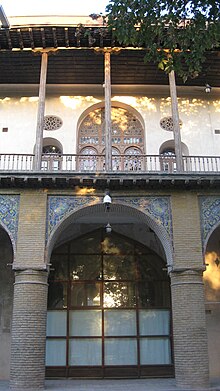Tschehel Sotun Pavilion
The Tschehel Sotun pavilion (also: Kakh-e Chehel Sotun , Chehel Sotoon , Persian كاخ چهل ستون, DMG kāḫ-e čehel sotūn , 'Forty Pillar Palace') is a Safavid , two-story garden palace from the early 16th century in Qazvin , Iran .
history
The pavilion is located in the center of the city, opposite the “Meydan-e Azadi”. It was built in 1510. The building can be traced back to the second Shah of the Safavid dynasty, Abu'l-Fatḥ Ṭahmāsp , who set up his royal seat in it. Since the pavilion once had a pointed roof with which it is said to have been reminiscent of a hat , it is still popularly known today as "Kolah-ye Farangi" ("Hat of the Franks"). The building is surrounded by an arcade . The arcade is accessible from all sides through portals. A gallery runs around the upper floor, from which the roof is supported by means of 32 cedar wood columns.
There is a hall on the ground floor. This is decorated with tile mosaics. There are also remains of wall paintings depicting people. Under the Qajars , they were sometimes covered with plaster and later artfully restored. Shah Abbas the Great is said to have been crowned in the pavilion in 1588 before moving his seat of government from Qazvin to Isfahan ten years later .
To the south of the Tschehel Sotun pavilion, the “Ali Qapu” gate closed off the government premises, to the east the harem with its gardens. To the west was "Meydan Square".
Today the pavilion houses a museum for calligraphic works .
See also
Web links
Coordinates: 36 ° 16 '6 " N , 50 ° 0' 18" O pavilion chehel sotoun . In: Ehsan Yarshater (Ed.): Encyclopædia Iranica (English, including references)
Individual evidence
- ↑ Berger, p. 238
- ↑ Andrew Burke, Mark Elliot, Iran (e-book version, lonley planet), p. 177 in the Google book search
- ↑ Peter Kerber, Iran: Islamic State with a culture that is thousands of years old , p. 184 in the Google book search
- ↑ Chehel Sotun calligraphy museum, Qazvin ( Memento of the original from February 10, 2016 in the Internet Archive ) Info: The archive link was inserted automatically and has not yet been checked. Please check the original and archive link according to the instructions and then remove this notice.
literature
- Hans Berger: Iran . Conrad Stein Verlag , 5th edition, 2001, ISBN 3-89392-273-3 (travel manual).
- RM Savory: ABBĀS (I) . In: Ehsan Yarshater (Ed.): Encyclopædia Iranica , as of December 15, 1982, accessed on June 9, 2011 (English, including references)

